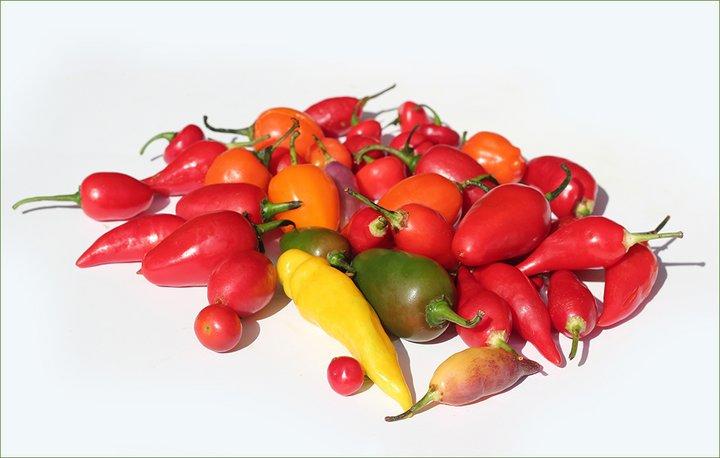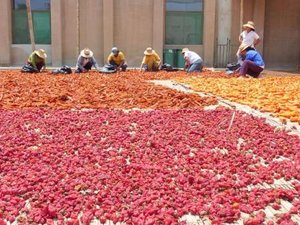Traits for taste: Spicing up the chilli market in Bolivia and Peru

Whether you like your chilli (Capsicum) peppers mildly spicy or ‘burn in the mouth’ hot, Peru and Bolivia have more than enough chilli varieties to satisfy your culinary cravings. A new paper examines the genetic traits that cause these taste differences and explores how creating links to markets could giving a much-needed income boost to the smallholder rural producers who grow and maintain them.
Whether you like your chilli peppers mildly spicy or ‘burn in the mouth’ hot, Peru and Bolivia have more than enough chilli (Capsicum) diversity to satisfy your culinary cravings.
Consumer interest in new flavours and health-related attributes had risen, leading food companies to seek out new crops and varieties to meet an emerging market for increasingly sophisticated palates and a more healthy food – in a similar way to the chocolate aficionados who are willing to pay top dollar for specific cocoa flavours, or consumers who are willing to pay for healthy and gluten-free quinoa grains.
The best place to begin this search is the Andean region in South America, the centre of origin for many traditional varieties, where chilli peppers are known as ají. Peru, for example, has the highest diversity in cultivated chilli peppers in the world, while Bolivia is the centre of origin for several cultivated and wild pepper varieties.
But while the differences in chilli varieties can be easily seen, smelled and tasted, little research has gone into mapping and studying the different traits and how this diversity of shapes, colours, flavours, pungency and health-related attributes could be linked to entrepreneurs, giving a much-needed income boost to the smallholder rural producers who grow and maintain them.
A 3–year initiative, led by Bioversity International through the CGIAR Research Program on Policies, Institutes and Markets, and the CGIAR Research Program on Agriculture for Nutrition and Health set out to change this.
The first step was to collect and screen traditional varieties to determine traits with the potential to be commercially viable, as Bioversity International scientist, Dr. Maarten Van Zonneveld, who led the collection and screening activities and lead author on a new paper ‘Screening genetic resources of Capsicum peppers in their primary centre of diversity in Bolivia and Peru’ explains:
“Crop diversity is often under-researched, a glaring omission for many highly diverse crops like Capsicum peppers. A relatively modest investment to screen this variation in its center of diversity for a wide range of traits can reveal many varieties of potential interest to breeders, growers, entrepreneurs and consumers in a relatively short period of time. To detect varieties for novel products that have distinguished values in capsaicinoids (responsible for the pungency), colour, flavonoids (including the health-related attribute quercetin) , Vitamin E, sugars, fat and/or sugars, extensive and innovative biochemical analyses were carried out through a successful collaboration between Wuppertal University in Germany, Proinpa and Pairumani in Bolivia, INIA Peru and Bioversity International."
The results of this work were two-fold:
We were able to detect 39 and 44 promising accessions in Peru and Bolivia respectively, conserved in genebanks, for a wide range of different purposes and uses. The collections in Peru and Bolivia provided the necessary diversity of selection. Peru now has one of the most diverse collections of native Capsicum ever assembled, representing a wide range of variation of the five cultivated peppers. The collection in Bolivia encompasses the five domesticated species and at least four wild taxa consumed by humans, including the recently discovered wild species C. caballeroi, which is unique to this collection.
 At the market level, analysis was done on national and international high value Capsicum niche markets, to identify opportunities and identify constraints, in terms of linking farmers to potential markets. From these analyses, steps were implemented, including facilitating access to promising seed material, training, publication of manuals and guides, and public awareness materials targeted at farmers, entrepreneurs and other value chain actors about the diversity of Capsicum and its potential uses.
At the market level, analysis was done on national and international high value Capsicum niche markets, to identify opportunities and identify constraints, in terms of linking farmers to potential markets. From these analyses, steps were implemented, including facilitating access to promising seed material, training, publication of manuals and guides, and public awareness materials targeted at farmers, entrepreneurs and other value chain actors about the diversity of Capsicum and its potential uses.
Promising varieties were also distributed to farmers for testing while new native chilli products for market were developed through collaborations between farmer groups, private sector bodies and research institutions– such as bottled, canned, and dried good, as well as jams and as added spice to a specialty cheese.
“The initiative has notably influenced new lines of research by partners in Bolivia and Peru,” explains Dr. Marleni Ramirez, general coordinator of the project. “The National Institute of Agricultural Innovation (INIA) in Peru has included all promising Capsicum materials identified in the study in their horticultural improvement programme, with several already identified for increased production as they matched the interests of several entrepreneurs who participated in workshops we hosted to share information our research. In Bolivia, there is a high demand for wild Capsicum but more research needs to be done on how to cultivate and harvest them sustainably. Pairumani, our partner in Bolivia, will take forward this research now”.
That Capsicum diversity in Bolivia and Peru is now receiving research and development interest and investment can only be good news for Capsicum consumers, entrepreneurs and smallholder producers alike. But matching diversity to entrepreneur and consumer interests need not stop there as Dr. van Zonneveld concludes:
“What is important to take away from this research initiative, is that the approach could be applied to many other highly diverse crops in their respective centres of diversity. Governments, the food industry and consumers in developed and developing countries are often not aware of the existence of crop diversity, both cultivated and wild, and the benefits of safeguarding and screening it for traits of interests – not just for high-end markets and improved livelihoods, but also for improved nutrition, or for increased resilience to climate change or to the many crop pests and diseases that are devastating harvests for many rural poor farming communities around the world.”
Download the paper:
Screening genetic resources of Capsicum peppers in their primary centre of diversity in Bolivia and Peru
For more information, contact: Maarten van Zonneveld
This work was supported by the German Society for International Collaboration, Gesellschaft für Internationale Zusammenarbeit (GIZ). It contributes to the CGIAR Research Programs on Policies, Institutes and Markets, and Agriculture for Nutrition and Health and Climate Change Agriculture and Food Security, and the Bioversity International Initiatives – Farms, Forests, Landscapes and Effective Genetic Resources Conservation and Use
Photos:
Upper - Chilli diversity. Credit: Bioversity International/C. Zanzanaini
Lower - Women selecting chillis for market/food industry, Peru. Credit: Bioversity International/X.Scheldeman
